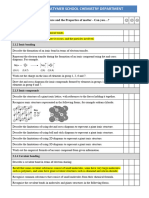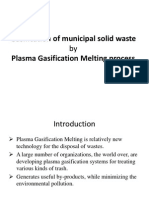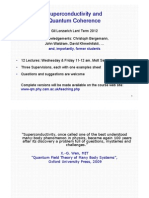Ionic Bonds & Lattice Structure (2.2.2) CIE IGCSE Chemistry Revision Notes 2023 Save My Exams
Ionic Bonds & Lattice Structure (2.2.2) CIE IGCSE Chemistry Revision Notes 2023 Save My Exams
Uploaded by
gkrauelCopyright:
Available Formats
Ionic Bonds & Lattice Structure (2.2.2) CIE IGCSE Chemistry Revision Notes 2023 Save My Exams
Ionic Bonds & Lattice Structure (2.2.2) CIE IGCSE Chemistry Revision Notes 2023 Save My Exams
Uploaded by
gkrauelOriginal Title
Copyright
Available Formats
Share this document
Did you find this document useful?
Is this content inappropriate?
Copyright:
Available Formats
Ionic Bonds & Lattice Structure (2.2.2) CIE IGCSE Chemistry Revision Notes 2023 Save My Exams
Ionic Bonds & Lattice Structure (2.2.2) CIE IGCSE Chemistry Revision Notes 2023 Save My Exams
Uploaded by
gkrauelCopyright:
Available Formats
GCSE IGCSE AS A Level O Level Pre U IB Log in Join now
CIE IGCSE Chemistry
Revision Notes
Home / IGCSE / Chemistry / CIE / Revision Notes / 2. Atoms, Elements & Compounds / 2.2 Ions & Ionic Bonds / 2.2.2 Ionic Bonds & Lattice Structure
2.2.2 Ionic Bonds & Lattice Structure 1. STATES OF MATTER
DOWNLOAD PDF TEST YOURSELF
2. ATOMS, ELEMENTS &
COMPOUNDS
The Lattice Structure of Ionic Compounds
2.1 Atomic Structure & the
EXTENDED Periodic Table
Lattice structure
2.2 Ions & Ionic Bonds
Ionic compounds have a giant lattice structure
Lattice structure refers to the arrangement of the atoms of a substance in
3D space 2.2.1 Ions & Ionic Bonds
In lattice structures, the atoms are arranged in an ordered and repeating
fashion
2.2.2 Ionic Bonds &
The lattices formed by ionic compounds consist of a regular arrangement
Lattice Structure
of alternating positive and negative ions
2.2.3 Properties of Ionic
Compounds
2.3 Simple Molecules &
Covalent Bonds
2.4 Giant Structures
The lattice structure of NaCl 3. STOICHIOMETRY
Ionic Bonds between Metallic & Non-Metallic Elements 4. ELECTROCHEMISTRY
EXTENDED
5. CHEMICAL ENERGETICS
Ionic compounds
Ionic compounds are formed when metal atoms and non-metal atoms react
The ionic compound has no overall charge 6. CHEMICAL REACTIONS
Example: Magnesium Oxide, MgO
7. ACIDS, BASES & SALTS
8. THE PERIODIC TABLE
9. METALS
10. CHEMISTRY OF THE
ENVIRONMENT
11. ORGANIC CHEMISTRY
Feedback
12. EXPERIMENTAL
TECHNIQUES &
Diagram showing the dot-and-cross diagram of magnesium oxide
CHEMICAL ANALYSIS
Explanation
Magnesium is a Group II metal so will lose two outer electrons to another
atom to have a full outer shell of electrons
A positive ion with the charge 2+ is formed
Oxygen is a Group VI non-metal so will need to gain two electrons to have a
full outer shell of electrons
Two electrons will be transferred from the outer shell of the magnesium
atom to the outer shell of the oxygen atom
Oxygen atom will gain two electrons to form a negative ion with charge 2−
Magnesium oxide has no overall charge
Formula of ionic compound: MgO
Exam Tip
When drawing dot and cross diagrams, you only need to show the
outer shell of electrons. Remember to draw square brackets and
include a charge for each ion. Make sure the overall charge is 0; you
may need to include more than one positive or negative ion to ensure
the positive and negative charges cancel each other out.
TEST YOURSELF NEXT TOPIC
Author: Caroline
Caroline graduated from the University of Nottingham with a degree in Chemistry and Molecular Physics. She spent several
years working as an Industrial Chemist in the automotive industry before retraining to teach. Caroline has over 12 years of
experience teaching GCSE and A Level Chemistry and is passionate about creating high-quality resources to help students
achieve their full potential.
Resources Members Company Quick Links
Home Members Home About Us GCSE Revision
Join Account Contact Us Notes
Support Login Jobs IGCSE Revision
Notes
Terms
A Level Revision
Privacy
Notes
Biology
Chemistry
Physics
Maths
2022 Advance
Information
© Copyright 2015−2023 Save My Exams Ltd. All Rights Reserved.
IBO was not involved in the production of, and does not endorse, the resources created by Save My Exams.
DOWNLOAD PDF
You might also like
- Chapter 7 AssessmentDocument18 pagesChapter 7 Assessmentsara fekriNo ratings yet
- Refrigeration Cycle Demonstration UnitDocument76 pagesRefrigeration Cycle Demonstration UnitRobert Gilmore100% (1)
- Piccolo Tube (Anti-Icing System)Document7 pagesPiccolo Tube (Anti-Icing System)sanjoshi21No ratings yet
- Ions & Ionic Bonds (2.2.1) CIE IGCSE Chemistry Revision Notes 2023 Save My ExamsDocument1 pageIons & Ionic Bonds (2.2.1) CIE IGCSE Chemistry Revision Notes 2023 Save My ExamsgkrauelNo ratings yet
- AQA GCSE Chemistry: 2.1.5 Metallic BondingDocument1 pageAQA GCSE Chemistry: 2.1.5 Metallic BondingZehmilNo ratings yet
- Covalent Bonds (2.3.1) CIE IGCSE Chemistry Revision Notes 2023 Save My ExamsDocument1 pageCovalent Bonds (2.3.1) CIE IGCSE Chemistry Revision Notes 2023 Save My ExamsgkrauelNo ratings yet
- Teknik JWB Kertas 3Document13 pagesTeknik JWB Kertas 3THANABALAN A/L MUNUSWAMY MoeNo ratings yet
- Least Learned Competencies: Subject Quarter Content Least Learned/Mastered Competency CodeDocument1 pageLeast Learned Competencies: Subject Quarter Content Least Learned/Mastered Competency CodeIlyn Domingo NupatNo ratings yet
- W3W4 BTD1123 Chapter 2 Mat Structure N BondingDocument62 pagesW3W4 BTD1123 Chapter 2 Mat Structure N BondingHakim ShahmiNo ratings yet
- 12A ''Metallic Bonding & Giant Metallic Structures'Document31 pages12A ''Metallic Bonding & Giant Metallic Structures'Uncharted FireNo ratings yet
- Chem Module 1 OnScreenDocument73 pagesChem Module 1 OnScreenLarah XeniaNo ratings yet
- CHAPTER II-Structure and Deformation in MaterialsDocument22 pagesCHAPTER II-Structure and Deformation in MaterialshaftamuNo ratings yet
- 4.2 Bonding, Structure and The Properties of MatterDocument6 pages4.2 Bonding, Structure and The Properties of MatterEashwar RajakumarNo ratings yet
- The Molecular World Printable PDFDocument98 pagesThe Molecular World Printable PDFmisterNo ratings yet
- Ifas Inorganic TecDocument25 pagesIfas Inorganic TectejaNo ratings yet
- General Chemistry (4th Quarterly Reviewer)Document5 pagesGeneral Chemistry (4th Quarterly Reviewer)Sunoo EnhypenNo ratings yet
- Chapter 2 - Silberberg ChemistryThe Molecular Nature of Matter and ChangeDocument50 pagesChapter 2 - Silberberg ChemistryThe Molecular Nature of Matter and Changeparkjihee906No ratings yet
- Solution Manual For Chemistry The Central Science 13th Edition by Brown LeMay Bursten Murphy Woodward Stoltzfus ISBN 0321910419 9780321910417Document36 pagesSolution Manual For Chemistry The Central Science 13th Edition by Brown LeMay Bursten Murphy Woodward Stoltzfus ISBN 0321910419 9780321910417jordansmithdfmigejpaq100% (41)
- Second QuarterDocument4 pagesSecond QuarterShellane Blanco SarduaNo ratings yet
- Diamond Stone International School IGCSE Weekly Lesson PlanDocument1 pageDiamond Stone International School IGCSE Weekly Lesson PlanjanithaNo ratings yet
- Chemistry Test 2: Date: 24/09/2020 Day: Thursday Topics/Chapters InvolvedDocument2 pagesChemistry Test 2: Date: 24/09/2020 Day: Thursday Topics/Chapters InvolvedRXNOFCHMNo ratings yet
- Work Done Potential Energy and Kinetic Energy PowerDocument3 pagesWork Done Potential Energy and Kinetic Energy PowerRenz Nikko CaballeroNo ratings yet
- C2-The Structure of The Atom - 0001Document25 pagesC2-The Structure of The Atom - 0001Christina T Z-chYnNo ratings yet
- GenChem1-CHEMICAL BONDING UPDocument3 pagesGenChem1-CHEMICAL BONDING UPRenz Nikko CaballeroNo ratings yet
- Attachment PDFDocument19 pagesAttachment PDFarifandiNo ratings yet
- 2019Tang-Carbon-metal Compound Composite Electrodes For Capacitive Deionization Synthesis, Development and ApplicationsDocument51 pages2019Tang-Carbon-metal Compound Composite Electrodes For Capacitive Deionization Synthesis, Development and ApplicationsLaura González SossaNo ratings yet
- 3 2 4-MacromoleculesDocument10 pages3 2 4-Macromoleculesareeb9187No ratings yet
- Chemical BondingDocument387 pagesChemical BondingAlan TeoNo ratings yet
- Meq431 NotesDocument578 pagesMeq431 NotesAlif SyafiqNo ratings yet
- Neet-Complete-Syllabus @iarthrajDocument28 pagesNeet-Complete-Syllabus @iarthrajløzanNo ratings yet
- Stewart 2021Document13 pagesStewart 2021shubhendurNo ratings yet
- Material Module 27328uDocument37 pagesMaterial Module 27328uArdhya GaNo ratings yet
- Chapter 4 Bonding Ionic-Metalli and GeometryDocument106 pagesChapter 4 Bonding Ionic-Metalli and GeometryPaula IscarNo ratings yet
- JEE Main Coordination Compounds Revision Notes Free PDF DownloadDocument6 pagesJEE Main Coordination Compounds Revision Notes Free PDF Downloadsanketwanave5524No ratings yet
- Mental Model TaskDocument2 pagesMental Model TaskNovianti IslahiahNo ratings yet
- Unit 2 Topic 2.3: Big IdeaDocument15 pagesUnit 2 Topic 2.3: Big Ideant7bpxsctsNo ratings yet
- LAS Sci9 q2 Week2 v3Document12 pagesLAS Sci9 q2 Week2 v3Jim TanNo ratings yet
- Shs Stem Specialized Subject: Gen. Chem1 - Q1 1. I. Matter and Its Properties - Q2 2.1 Electronic Structure of AtomDocument2 pagesShs Stem Specialized Subject: Gen. Chem1 - Q1 1. I. Matter and Its Properties - Q2 2.1 Electronic Structure of AtomFranklin BayaniNo ratings yet
- Tos FilipinoDocument2 pagesTos FilipinoRodel Fagsao Wad-inganNo ratings yet
- CH105Chapter 3 PDF InteractiveDocument14 pagesCH105Chapter 3 PDF Interactiveantonverr3No ratings yet
- Scheme of Work 5070 ChemistryDocument57 pagesScheme of Work 5070 ChemistryAshrafNo ratings yet
- Module 1Document45 pagesModule 1Leigh Kyster BenlotNo ratings yet
- CMC Chapter 07Document101 pagesCMC Chapter 07MattNo ratings yet
- CH 2 Chemical Bonding PDFDocument26 pagesCH 2 Chemical Bonding PDFTonald DrumpNo ratings yet
- Chemical BondingDocument7 pagesChemical Bonding76241717abelNo ratings yet
- LAS W2-PADAYAO&MORACA (Illustrated)Document8 pagesLAS W2-PADAYAO&MORACA (Illustrated)Nelson MongpongNo ratings yet
- Science9 Q2W2Document5 pagesScience9 Q2W2Norjannah BarodiNo ratings yet
- Aging Mechanisms of Electrode Materials in LithiumDocument12 pagesAging Mechanisms of Electrode Materials in Lithiumranjeetsharma029No ratings yet
- Matter Part 1Document4 pagesMatter Part 1Naguib ZakariaNo ratings yet
- OpenStax Chemistry Ch07 BlankDocument8 pagesOpenStax Chemistry Ch07 BlankThrustin FordNo ratings yet
- New Note Chapter 9 Structures and Properties of Substances - 2020 - Student VersionDocument46 pagesNew Note Chapter 9 Structures and Properties of Substances - 2020 - Student VersionkarinhyhoNo ratings yet
- Structures and Properties of Substances: Learning GoalDocument44 pagesStructures and Properties of Substances: Learning GoalRyanNo ratings yet
- Header Footer FileDocument2 pagesHeader Footer FileAnas AsgharNo ratings yet
- Scheme of Work: Cambridge O Level Chemistry 5070Document55 pagesScheme of Work: Cambridge O Level Chemistry 5070Syed Ashar50% (2)
- (CHEM CS) Chapter 2.3 - 2.5 - Chemical BondingDocument16 pages(CHEM CS) Chapter 2.3 - 2.5 - Chemical Bondingfayyaz haqueNo ratings yet
- 2.2.1 Electron Structure QPDocument5 pages2.2.1 Electron Structure QPshraddhabakshi12No ratings yet
- The Science and Engineering of Materials, 6 Ed: Chapter 2 - Atomic StructureDocument37 pagesThe Science and Engineering of Materials, 6 Ed: Chapter 2 - Atomic StructureattaurrehmanNo ratings yet
- SCINOTESDocument2 pagesSCINOTESMark Beduya CuffeeNo ratings yet
- Iron Oxide Chemistry. From Molecular Clusters To Extended Solid NetworksDocument7 pagesIron Oxide Chemistry. From Molecular Clusters To Extended Solid NetworksallNo ratings yet
- Chemical Science: CorrectionDocument4 pagesChemical Science: CorrectionRivaldiNo ratings yet
- 9701 Chemistry Learner Guide 2015.inddDocument84 pages9701 Chemistry Learner Guide 2015.inddSahana KumarNo ratings yet
- Science Quest 8 MatterDocument19 pagesScience Quest 8 MatterNoble_Truth50% (2)
- Gasification of Municipal Solid Waste in The Plasma Gasification Melting ProcessDocument23 pagesGasification of Municipal Solid Waste in The Plasma Gasification Melting ProcessArjuncv100% (3)
- Solution Thermodynamics:: ERT 206: Thermodynamics Miss Anis Atikah Ahmad Tel: 04-9763245 Email: Anis Atikah@unimap - Edu.myDocument58 pagesSolution Thermodynamics:: ERT 206: Thermodynamics Miss Anis Atikah Ahmad Tel: 04-9763245 Email: Anis Atikah@unimap - Edu.myDrakzNo ratings yet
- ASTM D2892-20 Standard Test Method For Distillation of Crude Petroleum (15-Theoretical Plate Column)Document34 pagesASTM D2892-20 Standard Test Method For Distillation of Crude Petroleum (15-Theoretical Plate Column)MahammadNo ratings yet
- 1 s2.0 S0894177722001856 MainDocument11 pages1 s2.0 S0894177722001856 MainDIEGO RAUL ARANCIBIA HUAMANNo ratings yet
- The Removal of CO2 and N2 From Natural GasDocument32 pagesThe Removal of CO2 and N2 From Natural GasMarwa J'mai100% (3)
- F1 - 30 Fluid Properties Apparatus - DatasheetDocument1 pageF1 - 30 Fluid Properties Apparatus - DatasheetBerlín LópezNo ratings yet
- Bostik Rheology Training Nov2nd, 2011 in AsiaDocument13 pagesBostik Rheology Training Nov2nd, 2011 in Asiapopmart21No ratings yet
- Jai Prakash (Chmeistry)Document14 pagesJai Prakash (Chmeistry)Jai PrakashNo ratings yet
- Solutions WorksheetDocument2 pagesSolutions WorksheetRoshini GopusankarNo ratings yet
- Components and Construction: LO3.2: Identify The Components of A Refrigeration SystemDocument50 pagesComponents and Construction: LO3.2: Identify The Components of A Refrigeration SystemBrianss AyangssNo ratings yet
- Buoyancy Forces in CT ApplicationsDocument3 pagesBuoyancy Forces in CT ApplicationsQazi WaqasNo ratings yet
- Unit 2 Pressure and Its Measurement 10CV35Document34 pagesUnit 2 Pressure and Its Measurement 10CV35p6a4nduNo ratings yet
- Vert Heater TreaterDocument2 pagesVert Heater TreaterJaveed KhanNo ratings yet
- Petroleum Engineering Fluid Properties - Data BookDocument67 pagesPetroleum Engineering Fluid Properties - Data BookMinh Hoàng NguyễnNo ratings yet
- Physics Tut Sheet 3 Dielectric PropertiesDocument2 pagesPhysics Tut Sheet 3 Dielectric PropertiesHarshit SoniNo ratings yet
- Hdpe Pe80 Din 8074 / Iso 4427Document79 pagesHdpe Pe80 Din 8074 / Iso 4427Steve WanNo ratings yet
- Colligative Properties of SolutionDocument15 pagesColligative Properties of SolutionJoon Bok NamleeNo ratings yet
- Lecture - SuperfluidityDocument17 pagesLecture - SuperfluidityKenion AssunçãoNo ratings yet
- Compressed Air Treatment, Drier and StorageDocument24 pagesCompressed Air Treatment, Drier and StorageAna PrisacariuNo ratings yet
- Alarm Trip Setting List 3Document35 pagesAlarm Trip Setting List 3Vraja KisoriNo ratings yet
- Hydrogen Shobhit NirwanDocument26 pagesHydrogen Shobhit NirwanANMOL SHREYAMNo ratings yet
- Chapter 10 SuperconductivityDocument73 pagesChapter 10 SuperconductivityYasin ÖztürkNo ratings yet
- Glass - Wikipedia 21Document1 pageGlass - Wikipedia 21A-ReaderNo ratings yet
- Gas Laws WorksheetDocument3 pagesGas Laws WorksheetJEROME CALUMBANo ratings yet
- Ethylene PipesDocument8 pagesEthylene Pipesingbarragan87No ratings yet
- Chapter 3: Forces and PressureDocument24 pagesChapter 3: Forces and PressureSiah Yih HoongNo ratings yet

























































































